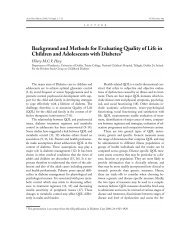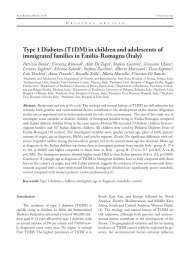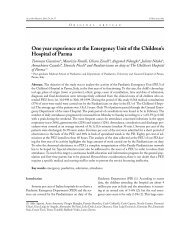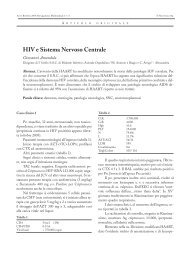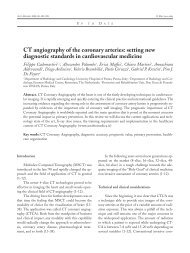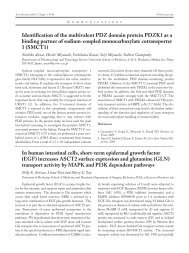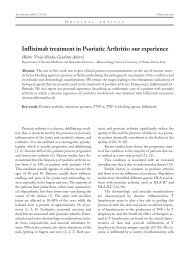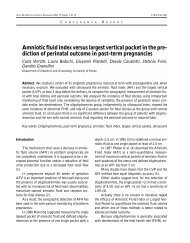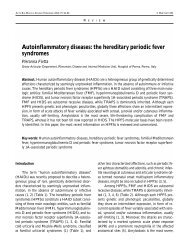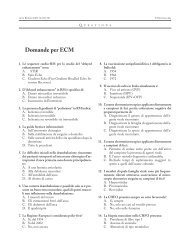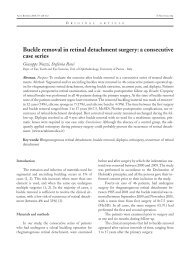Rehabilitative and infiltrative treatment with hyaluronic - Acta Bio ...
Rehabilitative and infiltrative treatment with hyaluronic - Acta Bio ...
Rehabilitative and infiltrative treatment with hyaluronic - Acta Bio ...
Create successful ePaper yourself
Turn your PDF publications into a flip-book with our unique Google optimized e-Paper software.
226 C. Costantino, S. Olvirri<br />
Hyaluronic acid is a polymer that is present at the<br />
articular level in a concentration of 2-3 mg/ml (16,<br />
17), which shows an analgesic effect on pain receptors,<br />
since it reduces the production of algogenic matter, interferes<br />
<strong>with</strong> some neuropeptides <strong>and</strong> presents mechanical<br />
functions of viscosupplementation <strong>and</strong> lubrication<br />
of the articular surfaces (18-22).<br />
The aim of this study is to evaluate the efficacy of<br />
the <strong>infiltrative</strong> <strong>treatment</strong> <strong>with</strong> <strong>hyaluronic</strong> acid associated<br />
<strong>with</strong> a targeted rehabilitative <strong>treatment</strong> in elderly<br />
patients <strong>with</strong> rotator cuff tear, who cannot be surgically<br />
treated, because of their comorbility or because they<br />
simply refuse the <strong>treatment</strong>.<br />
Materials <strong>and</strong> methods<br />
Twenty-two patients (14 men <strong>and</strong> 8 women, 70<br />
to 89 years, mean age 78.1) affected by rotator cuff<br />
tear, observed at the Department of Functional Rehabilitation<br />
of Parma were selected.<br />
Sixteen patients presented rupture of the right<br />
rotator cuff (dominant shoulder) <strong>and</strong> 6 pts. were affected<br />
on the left shoulder. Fourteen patients only affected<br />
by supraspinatus tendon tear, eight patients affected<br />
by supraspinatus tendons tear.<br />
The patients arrived at the physiatric examination<br />
<strong>with</strong> symptoms including sharp pain, significant<br />
loss of range of motion of the shoulder <strong>and</strong> loss of autonomy<br />
in daily life activities.<br />
The selected patients had a non-traumatic etiology<br />
of the rupture of the tendons, which was documented<br />
<strong>with</strong> the echographic or <strong>with</strong> the MRI imaging.<br />
All patients underwent an X-ray of the scapolohomeral<br />
joint, <strong>and</strong> presented other crippling diseases<br />
<strong>and</strong> refused surgical <strong>treatment</strong>.<br />
Therefore, a conservative <strong>treatment</strong> consisting in a<br />
series of 3 infiltrations (once a week) of <strong>hyaluronic</strong> acid<br />
(jointex starter molecular weight: 800-1200 kdalton)<br />
followed by a targeted rehabilitative intervention (passive<br />
<strong>and</strong> active assisted kinesitherapy) was proposed.<br />
The <strong>infiltrative</strong> technique <strong>with</strong> anterior access<br />
was employed (Fig. 1).<br />
At the beginning each patient was evaluated for<br />
pain through the Visual Analogic Scale (V.A.S.).<br />
Costant Murley <strong>and</strong> the Shoulder Rating Question-<br />
Figure 1. Intra-articular infiltration of hyaluronan<br />
naires were employed to evaluate the loss of range of<br />
motion of the shoulder <strong>and</strong> loss of autonomy in daily<br />
life activities.<br />
The Costant Murley (top mark: 100) is divided<br />
into 4 items: the first item measures pain <strong>and</strong> patients<br />
have to score it in a range from 0 (sharp pain) to 15<br />
(no pain). The second item is related to daily life activities<br />
<strong>and</strong> is divided into working activities, sport <strong>and</strong><br />
free time, quality of sleeping, <strong>and</strong> range of motion of<br />
the shoulder during several activities.<br />
The scale also evaluates the bending range (flexion,<br />
abduction, extra-intra rotation) <strong>and</strong> strength.<br />
The aim of the Shoulder Rating Questionnaire is<br />
to evaluate the seriousness of symptoms <strong>and</strong> the range<br />
of motion of the shoulder. It consists in the evaluation<br />
of pain, daily life activities, sporting activities, free<br />
time, patient’s satisfaction <strong>and</strong> recovery.<br />
Each patient after the <strong>infiltrative</strong> <strong>treatment</strong> underwent<br />
a series of 20 passive <strong>and</strong> active assisted kinesitherapy<br />
of the shoulder. A follow-up at the first,<br />
third <strong>and</strong> sixth month was carried out.<br />
Phase 1: weeks 0-2:<br />
• Stretching of the anterior, posterior <strong>and</strong> inferior<br />
articular capsule<br />
• Codman pendular exercises<br />
• Isometric exercises<br />
• Passive exercises to regain total R.O.M.<br />
• Self-assisted exercises <strong>with</strong> pulley<br />
Phase 2: weeks 2-4:<br />
• Stretching of the articular capsule<br />
• Exercises of passive <strong>and</strong> self-assisted movement<br />
• Muscular strengthening of the rotator cuff: first,<br />
closed kinetic chain exercises, then open kinetic<br />
chain exercises (3 series of 10 repetitions)<br />
(Fig. 2)



